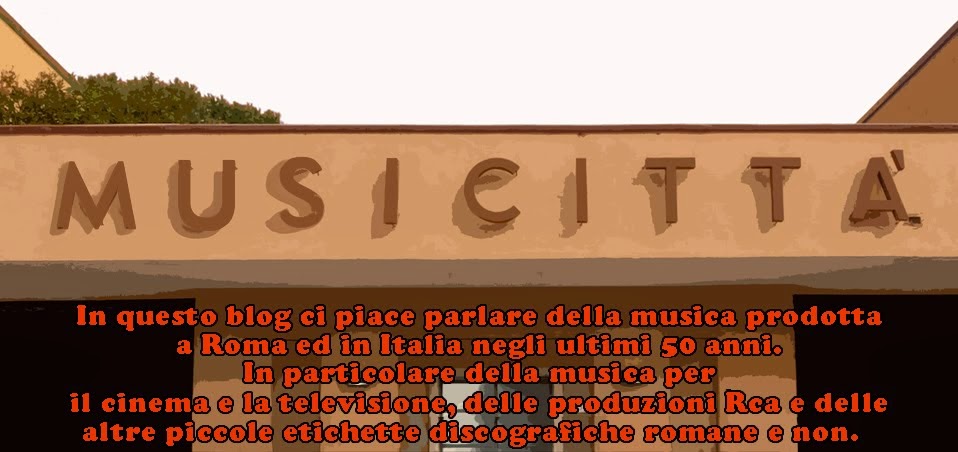Almeno sino all’inizio degli anni ottanta ci fu in Italia un fiorire di piccole case discografiche, la cui politica consisteva nel soddisfare quelle richieste del pubblico che le majors non riuscivano ad intercettare.
Nelle capitale nacquero diverse
etichette che spesso ruotavano intorno alla Rca, della quale sfruttavano gli studi di registrazione e la
distribuzione. Tra le tante posso indicare la Help, L’Apollo, La Picci, La
Delta, La Mimo, la Spaghetti, La It e la Parade.
Adesso voglio prendere in
considerazione proprio quest’ultima, la Parade.
La qualità dell’esiguo ma
prezioso catalogo di questa piccola casa discografica è sicuramente merito di
Vincenzo Micocci, direttore artistico della RCA Italiana che, lasciata Roma per
ricoprire lo stesso ruolo presso la Dischi Ricordi a Milano, nella primavera
del 1966 vi fece ritorno, per lavorare ad nuovo progetto discografico. L’idea
di Micocci era da un lato quella di
continuare la ricerca di nuovi talenti, dall'altro quella di proporre ad un pubblico più vasto le colonne sonore del
fiorente cinema italiano dell’epoca.
Fondò quindi la Parade insieme a Ennio
Morricone, Nico Fidenco e il paroliere Carlo Rossi. Micocci, nella ricerca di giovani
talenti, non tradì le aspettative: uno dei primi 45 giri pubblicati fu infatti
quello di un giovane cantautore napoletano,
Edoardo Bennato. L'attività continuò negli anni successivi, e tra gli
artisti scoperti e proposti al pubblico vi furono il gruppo napoletano degli
Alunni del Sole, i Calipop ed i Chetro
& Co. di Ettore De Carolis, uno dei pochi gruppi psichedelici italiani.
 |
| Ettore De Carolis, Marisa Solinas e Gianfranco Coletta |
Questo gruppo di Roma, composto da Ettore "Chetro" De Carolis (alla chitarra) e Gianfranco Coletta (anche lui alla chitarra e voce) e coadiuvato dai musicisti Gianni Ripani (basso) e Gegè Munari (batteria), realizzò per la Parade un singolo: Danze della sera (suite in modo psichedelico) b/w Le pietre numerate, con una splendida copertina apribile in quattro parti.
Come Le Stelle avevano
nell'artista Mario Schifano il loro supporter più importante, Chetro & Co.
vennero assistiti dal regista Pier Paolo Pasolini, i cui versi (da una poesia
chiamata Notturno tratta dalla raccolta L’usignolo della chiesa cattolica)
vennero usati come testi per Danze della
sera.
Entrambi i brani propongono
particolari sonorità grazie all’ausilio di strumenti ad arco e a fiato, che insieme
danno origine ad un unico stile ipnotico, forse più onirico che psichedelico e
di chiara derivazione orientale. C’è una attenta cura ad ogni più piccola
sfumatura: addirittura, nel brano Danze della sera, De Carolis usò la
violaccia, uno strumento ad arco di sua invenzione con 6 o 10 corde che
nell'aspetto assomiglia ad una ghironda.
Sul retro, vi è Le pietre
numerate, una marcetta acid beat che spatola suoni come fossero colori ed è la
trasposizione musicale del collage in copertina, dove, in una
fantasticheria pop psichedelica di derivazione beatlesiana, volteggiano Dylan insieme ad Allen Ginsberg,
Fellini, Totò, Pasolini che gioca a calcio, Mandrake e gli altri eroi dei
fumetti.
Ad un attento ascolto però si può
rintracciare la genesi del brano, che è un omaggio al Miles Davis di Milestones
del 1958, il tema e l’armonia del brano omonimo sono ricalcate con mano felice
dal gruppo romano. Emblematica a tal proposito è la presenza nel collage di una
foto di Davis col fido John Coltrane: nell’album Milestones i due cominciarono
l’esplorazione nel jazz modale che ebbe enorme impatto sulla
psichedelia degli anni 60, basti pensare, ad esempio, al brano Eight Miles High
dei Byrds.
Purtroppo il disco non ebbe il
riconoscimento che meritava, troppo moderno per i tempi e evidentemente troppo
ardito nei testi. Venne censurato dalla RAI : "Danze della sera" fu
bandita dalla programmazione del popolare contenitore radiofonico
"Bandiera Gialla" per la frase "Ormai sono quasi nudo per venire
a te".
Un critico recensì il disco con queste parole: “Con la
complicità di Pier Paolo Pasolini, Chetro & C0. hanno combinato un
pasticcio intellettual-pschichedelico, noioso, anticommerciale e di scarso
effetto. Danze della sera contiene una lirica di Pasolini, piuttosto bella e
profonda, se non detta in musica.”: Un’accoglienza frutto dell’arretratezza e
dall’impreparazione della critica dell’epoca.
L’avventura dei Chetro & Co.iniziò
e terminò con questo 45: Gianfranco Coletta fece poi parte della prima formazione
del Banco del Mutuo Soccorso e della Reale accademia di musica, il De Carolis si
dedicò ad un folk più schietto, curando anche gli arrangiamenti per alcuni
dischi di Francesco Guccini e di Claudio Lolli e compose sigle per la radio e
per la tv.
Nell’asfittico panorama rock
italiano dell’epoca un gioiello come questo 45 è divenuto con il tempo un disco
molto ricercato dai cultori del progressive e della psichedelica italiana, un vero capolavoro da accostare a
dischi come Le stelle di Mario Schifano o il primo lp psichedelico delle Orme Ad
Gloriam.
 |
| Gianfranco Coletta nel 1967 |
Ringrazio per le foto della copertina Pasquale Citriniti
Buon Ferragosto a tutti.


















